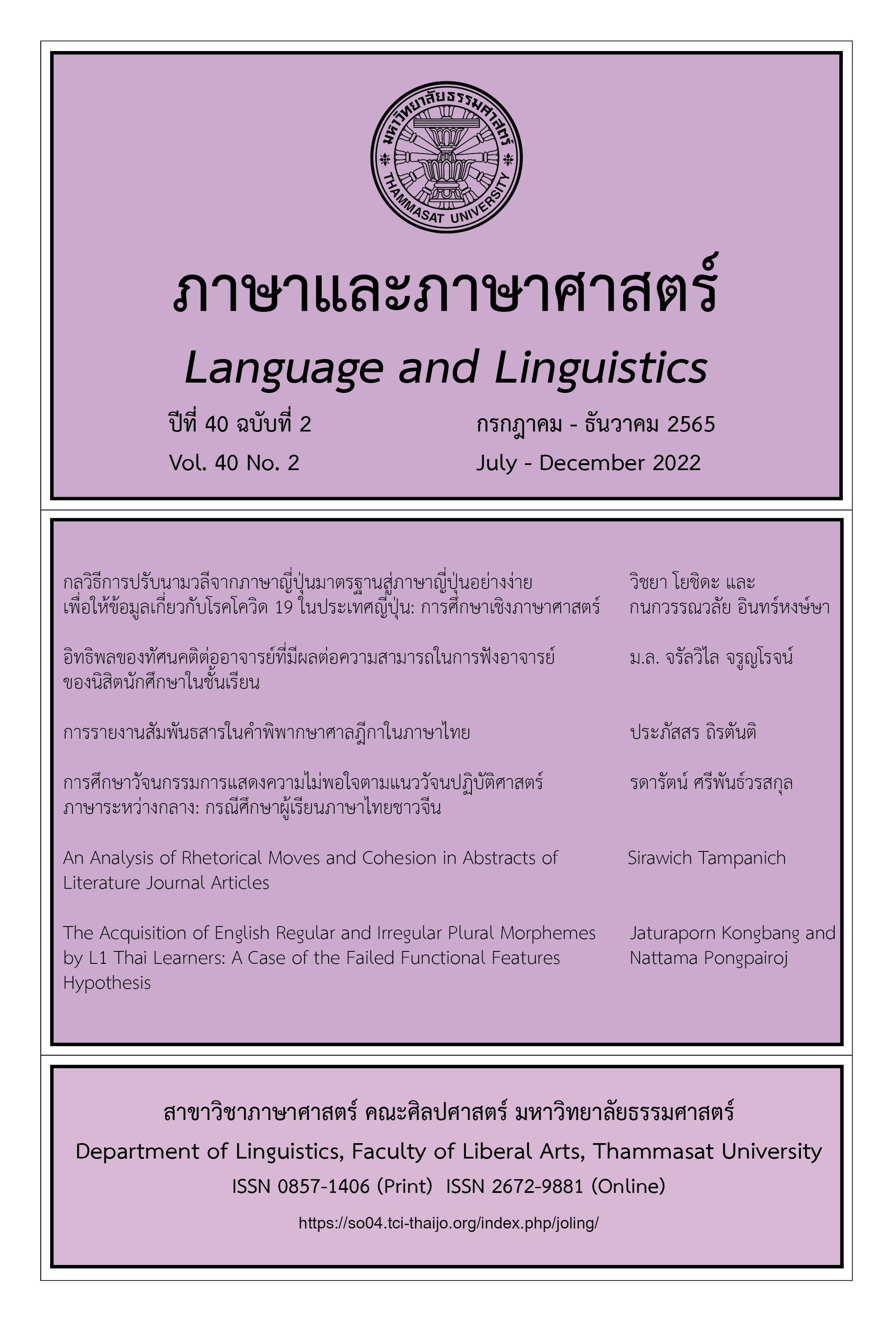The Acquisition of English Regular and Irregular Plural Morphemes by L1 Thai Learners: A Case of the Failed Functional Features Hypothesis
Main Article Content
Abstract
The purpose of the present study is to examine whether L1 Thai learners, whose native language lacks the plural inflection morphology, have acquired English regular and irregular plural morphemes and to see whether variability of L2 English regular and irregular plural morphemes by L1 Thai learners is caused by non-target-like syntactic representations under the assumption of the Failed Functional Features Hypothesis (FFFH). The participants were 36 Thai learners of English divided into two groups based on their proficiency levels: intermediate and advanced. Data were collected from a grammaticality judgement task and a cloze test. The results confirmed the Failed Functional Features Hypothesis (Franceschina, 2001; Hawkins & Chan, 1997) and contradicted the Missing Surface Inflection Hypothesis (Lardiere, 1998; Prévost & White, 2000) in that the L1 Thai learners failed to acquire English regular and irregular plural morphemes due to non-existence of plural inflection in Thai. Moreover, their use and judgement of L2 English plural morphemes was rather unsystematic. While some L1 Thai learners were assumed to draw upon their L1 knowledge to complete the tasks, others possibly resorted to linguistic cues showing plurality. The study contributes to Second Language Acquisition with respect to L2 variability and representation.
Article Details

This work is licensed under a Creative Commons Attribution-NonCommercial-NoDerivatives 4.0 International License.
บทความทุกบทความเป็นลิขสิทธิ์ของภาษาและภาษาศาสตร์
References
Adejare, R. A. (2019). The acquisition and use of the -s plural morpheme by third-year students of English in a Nigerian university. Open Journal of Modern Linguistics, 9(6), 416-445.
Altarawneh, S. M., & Hajjo, M. H. (2018). The acquisition of the English plural morphemes by Arabic-Speaking EFL learners. International Journal of Education and Literacy Studies, 6(2), 34-39.
Chaengchenkit, R. (2011). Explaining optionality in the use of English tense and agreement morphology by native speakers of Thai [Unpublished doctoral thesis]. University of Essex.
Dulay, H., & Burt, M. (1974). Natural sequences in child second language acquisition. Language Learning, 24(1), 37-53.
Franceschina, F. (2001). Morphological or syntactic deficits in near-native speakers? An assessment of some current proposals. Second Language Research, 17(3), 213-247.
Hawkins, R., & Chan, C. Y. (1997). The partial availability of universal acquisition: The ‘failed functional features hypothesis.’ Second Language Research, 13(3), 187-226.
Hawkins, R., & Liszka, S. (2003). Locating the source of defective past tense marking in advanced L2 English speakers. In R. van Hout, A. Hulk, F. Kuiken & R. J. Towell (Eds.), The lexicon-syntax interface in second language acquisition acquisition (pp. 21-44). John Benjamins.
Iwasaki, S., & Ingkaphirom, P. (2005). A reference grammar of Thai (1st ed.). Cambridge University Press.
Jia, G. (2003). The acquisition of English plural morpheme by native Mandarin Chinese-speaking children. Journal of Speech, Language, and Hearing Research, 46(6), 1297-1311.
Lardiere, D. (1998). Case and tense in the ‘fossilized’ steady state. Second Language Research, 14 (1), 1-26.
Lieber, R. (2010). Introducing morphology. Cambridge University Press.
Murphy, R. (1985). English grammar in use: A self-study reference and practice book for intermediate learners of English. Cambridge University Press.
Ninpanit, S., & Pongpairoj, N. (2016). The acquisition of the English plural morpheme by L1 Thai learners: A case of the Failed Functional Features Hypothesis. Pasaa Paritat Journal, 31, 53-79.
Pongpairoj, N. (2002). Thai university undergraduates’ errors in English writing. Journal of Language and Linguistics, 20(2), 66-99.
Phootirat, P. (2018). The role of stylistic variation and language proficiency level in the L2 acquisition of English plurality. Humanities Journal, 25(2), 62-85.
Piriyawiboon, N. (2010). Classifiers and determiner-less languages: The case of Thai [Unpublished doctoral dissertation]. University of Toronto.
Prévost, P., & White, L. (2000). Missing surface inflection or impairment in second language acquisition? Evidence from tense and agreement. Second Language Research, 16(2), 103-33
Radford, A. (2004). English syntax: An introduction. Cambridge University Press.
Rovinelli, R. J., & Hambleton, R. K. (1976). On the use of content specialists in the assessment of criterion-referenced test item validity. The University of Massachusetts.
Selinker, L. (1972). Interlanguage. International Review of Applied Linguistics, 10(3), 209-131.
Smith, N., & Tsimpli, I. (1995). The mind of a savant: Language learning and modularity. Blackwell.
Sridhanyarat, K., & Chaengchenkit, R. (2013). Acquisition of grammatical morphemes by Thai EFL learners. International Graduate Conference Proceedings by LITU, 2(1), 933-941.
Syndicate, U. C. L. E. (2001). Quick placement test. Oxford University Press.
Thapthimhin, T., & Pongpairoj, N. (2015). Target-like syntactic representations of L1 Thai learners: A case of L2 English number agreement. Language Education and Acquisition Research Network (LEARN) Journal, 8(2), 126–144.
Tsimpli, I. M., & Dimitrakopoulou, M. (2007). The interpretability hypothesis: Evidence from wh-interrogatives in L2 acquisition. Second Language Research, 23(2), 215-242.
Watcharapunyawong, S., & Usaha, S. (2012). Thai EFL students' writing errors in different text types: The interference of the first language. English Language Teaching, 6(1), 67-78.
White, L. (2003). Second language acquisition and universal grammar. Cambridge University Press.
Widiatmoko, P. (2008). Grammatical morpheme acquisition: An analysis of an EFL learner’s language samples. Jurnal Sastra Ingglis, 8(1), 22-37.
Zeelenberg, R., & Pecher, D. (2015). A method for simultaneously counterbalancing condition order and assignment of stimulus materials to conditions. Behavior Research Methods, 47(1), 127-133


